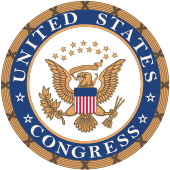
Back Session conjointe du Congrès des États-Unis French アメリカ合衆国議会合同会議 Japanese 미국 의회의 합동 회의 Korean Phiên họp chung Quốc hội Hoa Kỳ Vietnamese 美国国会联席会议 WUU 美國國會聯席會議 Chinese
Joint session of the United States Congress | |
|---|---|
 Seal of the United States Congress | |
| History | |
| Founded | March 4, 1789 |
| Leadership | |
| Structure | |
| Seats | 535 voting members
|
 | |
Senate political groups |
|
 | |
House of Representatives political groups |
|
| Meeting place | |
 | |
| House of Representatives Chamber United States Capitol Washington, D.C. United States of America | |
| Constitution | |
| United States Constitution | |
A joint session of the United States Congress is a gathering of members of the two chambers of the bicameral legislature of the federal government of the United States: the Senate and the House of Representatives. Joint sessions can be held on any special occasion, but are required to be held when the president delivers a State of the Union address, when they gather to count and certify the votes of the Electoral College as the presidential election, or when they convene on the occasion of a presidential inauguration. A joint meeting is a ceremonial or formal occasion and does not perform any legislative function, and no resolution is proposed nor vote taken.
Joint sessions and meetings are usually held in the Chamber of the House of Representatives, and are traditionally presided over by the speaker of the House. However, the Constitution requires the vice president (as president of the Senate) to preside over the counting of electoral votes.
Cite error: There are <ref group=lower-alpha> tags or {{efn}} templates on this page, but the references will not show without a {{reflist|group=lower-alpha}} template or {{notelist}} template (see the help page).